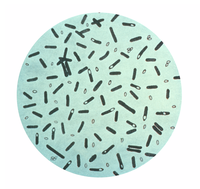
Photo from wikipedia
Three patients with severe Clostridium difficile infection (CDI) caused by an unusual strain of C. difficile, PCR ribotype (RT) 251, were identified in New South Wales, Australia. All cases presented with… Click to show full abstract
Three patients with severe Clostridium difficile infection (CDI) caused by an unusual strain of C. difficile, PCR ribotype (RT) 251, were identified in New South Wales, Australia. All cases presented with severe diarrhoea, two had multiple recurrences and one died following a colectomy. C. difficile RT251 strains were isolated by toxigenic culture. Genetic characterisation was performed using techniques including toxin gene profiling, PCR ribotyping, whole genome sequencing (WGS), in-silico multi-locus-sequence-typing (MLST) and core-genome single nucleotide variant (SNV) analyses. Antimicrobial susceptibility was determined using an agar incorporation method. In vitro toxin production was confirmed by Vero cell cytotoxicity assay and pathogenicity was assessed in a murine model of CDI. All RT251 isolates contained toxin A (tcdA), toxin B (tcdB) and binary toxin (cdtA and cdtB) genes. Core-genome analyses revealed the RT251 strains were clonal, with 0-5 SNVs between isolates. WGS and MLST clustered RT251 in the same evolutionary clade (clade 2) as RT027. Despite comparatively lower levels of in vitro toxin production, in the murine model RT251 infection resembled RT027 infection. Mice showed marked weight loss, severe disease within 48 h post-infection and death. All isolates were susceptible to metronidazole and vancomycin. Our observations suggest C. difficile RT251 causes severe disease and emphasise the importance of ongoing surveillance for new and emerging strains of C. difficile with enhanced virulence.
Journal Title: Anaerobe
Year Published: 2019
Link to full text (if available)
Share on Social Media: Sign Up to like & get
recommendations!